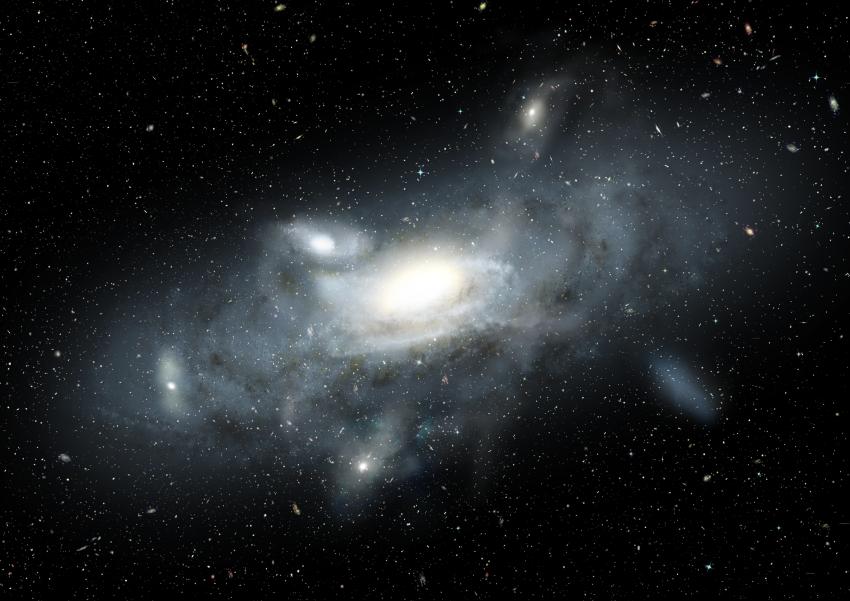Distant galaxy mirrors the early Milky Way

An artist’s impression of our Milky Way galaxy in its youth. Five small satellite galaxies, of various types and sizes, are in the process of being accreted into the Milky Way. These satellite galaxies also contribute globular star clusters to the larger galaxy. The Sparkler galaxy provides a snap-shot of an infant Milky Way as it accretes mass over cosmic time. Credit James Josephides, Swinburne University of Technology.
In summary
- A galaxy has been discovered that mirrors the very early version of the Milky Way
- Dubbed ‘The Sparkler’, the galaxy is embedded in a system of globular clusters and satellite galaxies and appears to be swallowing them as it grows
- The Sparkler was discovered using some of the first data from the James Webb Space Telescope (JWST)
A galaxy has been discovered that mirrors the very early version of our own galaxy, the Milky Way. Dubbed ‘The Sparkler’, the galaxy is embedded in a system of globular clusters and satellite galaxies and appears to be swallowing them as it grows.
The Sparkler was discovered by Swinburne’s Professor Duncan Forbes and Professor Aaron Romanowsky of San Jose State University, using some of the first data from the James Webb Space Telescope (JWST).
Named for its two-dozen orbiting globular clusters, the Sparkler provides unique insight into the formation history of the Milky Way during its infancy. Globular clusters are dense collections of around a million stars. The Milky Way is currently host to around 200 globular clusters.
The Sparkler can be found in the constellation of Volans in the southern sky. The galaxy and its system of globular clusters have been detected at a redshift of 1.38, which implies that we are seeing the galaxy around nine billion years ago, some four billion years after the Big Bang.
The research examined the age and metallicity distribution of a dozen of the compact star clusters surrounding the Sparkler to determine that they resemble younger versions of the clusters now around the Milky Way.
Several have old formation ages and are metal-rich, similar to those seen in the bulge of the Milky Way, and so are likely to be globular clusters.
A couple of star clusters had intermediate ages and were metal-poor – these clusters are associated with the satellite galaxy that is being accreted onto the Sparkler galaxy; it appears to be swallowing up this satellite galaxy and its system of globular clusters, just like the Milky Way has done in the past.
Although the Sparkler is currently only three per cent the mass of the Milky Way, it is expected to grow over cosmic time to match the Milky Way’s mass in the present-day Universe. The team will need deeper imaging to detect more clusters and satellites around the Sparkler.
“We appear to be witnessing, firsthand, the assembly of this galaxy as it builds up its mass – in the form of a dwarf galaxy and several globular clusters,” says Professor Forbes.
“We are excited by this unique opportunity to study both the formation of globular clusters, and an infant Milky Way, at a time when the Universe was only one third of its present age."
Co-author Professor Aaron Romanowsky says, “The origin of globular clusters is a long-standing mystery, and we are thrilled that JWST can look back in time to see them in their youth.”
The research was published in Monthly Notices of the Royal Astronomical Society.
-
Media Enquiries
Related articles
-

- Astronomy
- Technology
- Science
Swinburne’s Spotlight on STEM: A Night of Space Innovation with Shelli Brunswick
Swinburne University hosted a Spotlight on STEM event with space innovator Shelli Brunswick, exploring space technology, leadership, and career opportunities in the space industry
Friday 21 March 2025 -

- University
- Astronomy
- Science
‘Big Wheel’ disk galaxy discovered accidentally by international team
An international team involving Swinburne University of Technology has discovered a giant spiral disk galaxy in the early cosmos.
Tuesday 18 March 2025 -

- University
- Astronomy
Swinburne student presents lunar research at the 75th International Astronautical Congress
Swinburne student Erin Rose recently presented her research on lunar lava tubes at the International Astronautical Congress in Milan
Wednesday 22 January 2025 -

- Astronomy
- Technology
- Science
Australia’s moon rover takes off with Swinburne University of Technology developing critical technology for success
Swinburne University of Technology has been selected as a research university that will deliver key technology for Australia’s first lunar rover.
Tuesday 17 December 2024 -

- Astronomy
Swinburne astrophysicist Dr Rebecca Davies named a 2024 Superstar of STEM
Wednesday 11 December 2024

